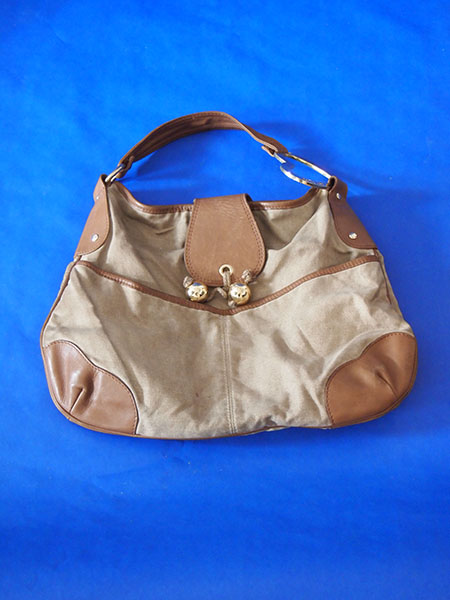![]() body | color | collections | commodity | cube | document | fabric | fetish | gender | glass | home | identity | living | machine | metal | minimal | mobility | narrative | olfactory | organic |
body | color | collections | commodity | cube | document | fabric | fetish | gender | glass | home | identity | living | machine | metal | minimal | mobility | narrative | olfactory | organic |
![]() pain | paper | plastic | plugs | power | protective | rectangular | ritual | round | sound | souvenir | spiritual | style | text-based | time | tool | touch | uniform | value | visual | warm | wood
pain | paper | plastic | plugs | power | protective | rectangular | ritual | round | sound | souvenir | spiritual | style | text-based | time | tool | touch | uniform | value | visual | warm | wood
| Outerwear: Felix Rey Tan Brown Purse | |||
Narrative: Tan Brown Purse with big gold metal heart on handle and magnetic closure. Felix Rey New York. Leather, cloth, magnet, and metal. Friend Lily Rafii Band started Felix Rey with partner Sulaika Zarrouk in Manhattan. I occasionally receive a gift of a Felix Rey purse from supporters of the company. This purse was given to me as a holiday gift in 2008. It traveled with me from Brooklyn to Queens to Manhattan to Brooklyn. Antelope, buckskin, lambskin, sheepskin, and cowhide are the hides most commonly used to make leather jackets. As soon as the skin is removed from the animal at the meat processing plant, it is refrigerated, salted, or packed in barrels of brine. It is then sent to the tannery where the skins undergo a series of processes designed to preserve and soften the hides. Sewing materials such as thread, lining, seam tape, buttons, snaps, and zippers are generally purchased from outside vendors and stored in the garment factory. The skins are trimmed and sorted according to size, weight, and thickness. It is necessary to remove any remaining proteins that could stimulate the growth of bacteria. To this end, the skins are soaked in revolving drums filled with water, bactericides, and detergents. Hair is removed with the application of chemical sprays or lime solutions. A scudding machine fitted with dull blades scrapes off any excess hair. After the skins have been tanned, they are washed once again and wrung out thoroughly. Then the skins are passed under a band knife, which cuts the skins to a uniform thickness, and placed on conveyer belts which carry them to drying tunnels. Usually, the skins are stretched on frames to prevent shrinkage during the drying stage. The hides are sprayed with water and soap and allowed to hang for a period of time. In the final drying period, the hides are hung in vacuum-drying cabinets. When the skins are thoroughly dried, they are buffed with revolving steel cylinders covered with abrasive paper. Suede finishes are produced by passing the hides under high-speed emery wheels. At this point, glazes, dyes, and lacquers are applied. The skins are now ready to be sent to the garment factory. Cotton thread is made of the cellulose from plants. Cotton is picked from cotton plants in the field and compressed into large bales. At a mill the bale is broken, the fibers are opened by a comb-like device, mixed together, and cleaned. The cleaned cotton fibers are called laps. The laps are fed into a carding machine that separates the fibers. Further cleaning, combing, and sorting readies the fibers for processing into thread. Buttons and labels are made from recycled PET plastic from bottles. Workers sort the bottles by color, separating green ones from clear ones. Then workers visually inspect each piece, and remove any foreign objects. The sorted plastic then moves into a sterilizing bath. The clean containers are dried and crushed into tiny chips. The chips are washed again, and the light-colored batch is bleached. Chips from green bottles stay green, and become yarn that will be dyed a dark color. When the chips are thoroughly dry, they are emptied into a vat and heated, then formed. |
 |
||
![]()
